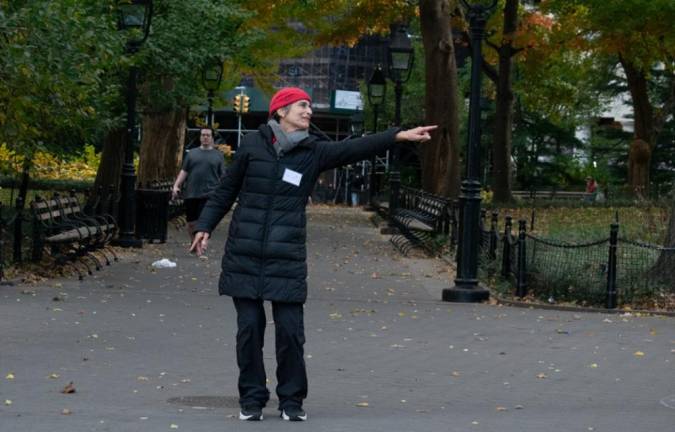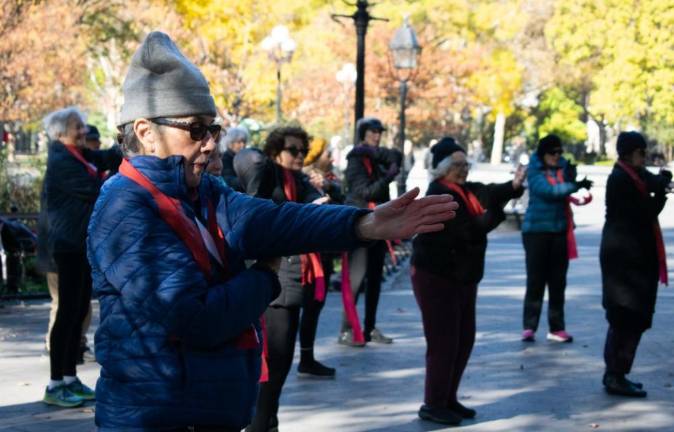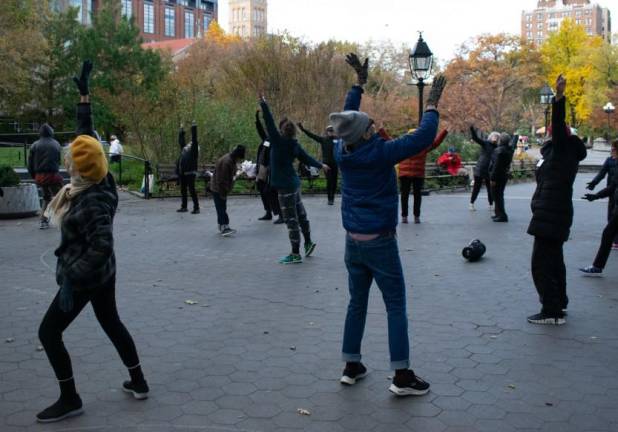Reaching for the Sky, Dance Leader Helps Seniors Combat Loneliness and Stay Fit
Naomi Goldberg-Haas, now 63 has been battling Lupus since she was 26. But the lifelong dancer started teaching dance over 35 years ago in LA and founded Dances for a Variable Population in NY in 2009. Each week, she leads a dedicated group of seniors in dance instructions outdoors in Washington Square Park.
On a brisk morning in November, Naomi Goldberg-Haas, a thin woman of 63, stood ramrod straight as she prepared to lead a class of 20 dancers in Garibaldi Plaza in Washington Square Park.
“Stretch your arms to the sky,” Goldberg-Haas said quietly, leading her dancers through a series of dances meant to improve mobility and creative expression. Her dance assistant, Casie McManus, repeated each instruction more loudly. Goldberg-Haas has Lupus, a disease which impedes her ability to talk and causes some motor issues, necessitating dance instructors like McManus to help project her instructions during her classes.
She was diagnosed at the young age of 26, but it has not dampened her spirit or her mission to bring dance to a wider audience. The dancers, all over the age of 70, wore large jackets and jeans or khakis to keep out the morning chill. Park visitors stopped to watch, occasionally snapping pictures. A statue of Giuseppe Garibaldi, for whom the plaza is named, looked down at the dancers as they moved from one side of the plaza to the other.
The class grabbed resistance bands, chatting amongst themselves, inquiring about family, sharing news that someone’s grandson had a baby, or asking if others heard that so-and-so passed away. Next, Goldberg-Haas and McManus encouraged their students to “move freely through the space around them.”
The group stretched their arms towards the sky, moving their legs aerobically. They moved confidently past one another, reminiscent of a childhood ballet class. Shockingly in a city of pricey workout classes and luxury gyms, this dance class is free.
The class is sponsored by Dances for a Variable Population, founded by Goldberg-Haas herself in 2009, although she’s taught since 2000. The classes, trademarked “Movement Speaks” attract older adults in public places like Washington Square, libraries, senior centers, and on Zoom. Today, DVP has 16 teachers and staff; two lead each class.
“Naomi is a wonderful woman,” said Victor Yohay, who has attended the classes for almost 20 years. He has a crop of white hair and wore a tan gambler hat during the class. “She brought us all together to take these classes.” Yohay, a retired architect whose wife has Alzheimer’s disease and lives in assisted living, called the class a great way to remain active and to be around people. As he spoke, Goldberg-Haas buzzed over to us on tiptoe.
“Separate, separate!” she said, interrupting the chat Yohay laughed. “Uh-oh, we’ve really pissed her off,” he said. Goldberg-Haas does not mess around, probably the result of her discipline as a lifelong dancer. She started at such a young age that she can’t remember when she began to dance. She grew up in New Jersey, with a neurologist and psychiatrist for a father and a teacher for a mother. At the age of 18, she began her career at the Pacific Northwest Ballet, before moving back to New York City where she majored in dance at Barnard. She studied under the improvisation guru Martin Keogh before earning her MFA from NYU’s Tisch School of the Arts.
Although Goldberg-Haas taught DVP-style classes in Los Angeles beginning in 1988, her idea arrived in New York in the form of a class at NYU in 2002. When asked why she started the classes, she said simply, “It was clear that the need was so strong.” The class doubled in size from the first to second semester, and the organization has taken off since then. Today, Goldberg-Haas serves as the founding artistic director of DVP, which receives funding from private donations, government grants, and educational grants (like a recent grant from NYU Tisch School of the Arts). At home, her family is reflective of her creative spirit. She lives with her husband, Brian, who is the head of the theater department at Columbia University. They have one child, Noah, who is currently attending Johns Hopkins for a doctorate in History.
Goldberg-Haas’s work demonstrates the positive impact that dance can have on older bodies and minds. A growing body of research shows that effect, including work by Dr. Sarah Astill of the University of Leeds. In one study, Astill and her team showed that dance classes twice a week for eight weeks could help mitigate the risks of falling.
“If you look at evidence for falls, there’s not a lot of really hard evidence about what prevents falls–other than that group activity and tai chi help prevent them,” said Astill. “The thing about dance is that it is the Western equivalent of tai chi.”
Ellis Wood, the managing director of DVP, reported that falling is one of older dancers’ greatest expressed fears. In response, the organization began handing out pamphlets at each class on reducing the risk of falls. Dancing has other physical benefits. A study done by Dr. Justin Keogh, an exercise scientist, found that “older adults can significantly improve their aerobic power, lower body muscle endurance, strength and flexibility, balance, agility, and gait through dancing.”
”Psychological benefits abound, too. Studies show that engaging in dance significantly improves older adults’ mental health, more so than other typical exercise regimens like walking or lifting weights,” she said. The explanation? “People are less emotionally engaged in exercise than in dancing,” said Dr. Louis Breher, who directs the EPIC Center at the Montreal Heart Institute. Dance classes create a sense of community that individual exercise classes may not provide, an antidote to loneliness and cognitive decline.
Goldberg-Haas had her own explanation. “Dance is better than just exercise because it involves creativity and it involves making something,” she said. “We have to combat loneliness by creating social situations where older people can come together and do things together. ”Loneliness certainly is the silent killer. Social isolation is associated with a 29 percent increase in risk of heart disease and a 32 percent increased risk of stroke, according to the CDC; it’s also associated with higher rates of depression, anxiety, suicide, cognitive decline and Alzheimer’s disease, and obesity.”
Accounting for mental health risks in older adults, Dances for a Variable Population hired a social worker and a therapist to train their dance instructors on how to recognize signs of mental distress among their dancers. Older dancers find the community so strong that, in September of this year, they refused to have their dance performance canceled, despite extreme flooding throughout New York City the day before.
“Honestly, I think our dancers love to dance,” said McManus, “but I think they love socializing even more.” A week later, the same group of dancers was ready to move bright and early in Washington Square Park. They chatted, calling each other by name, and moved through the movements with precision as Goldberg-Haas once again led them with expert focus. One student, Victor Rowland, has not missed a class in the 18 months since he began attending. “His movement was relatively limited at the beginning,” said McManus. “And he’s now able to do all of the dances and has become way more confident.”
Goldberg-Haas’s dedication to dance and her work has not waned over the years. She remains committed to dance and to the positive impacts that she sees. When asked what her greatest challenge in life was, she responded quickly: “Inspiring people to dance.”
She hopes that DVP can expand to other New York neighborhoods and, eventually, to other cities. “There are possibilities that are endless,” said Goldberg-Haas. “There are dancers and older adults everywhere.”
“Dance is better than just exercise because it involves creativity and it involves making something. We have to combat loneliness by creating social situations where older people can come together and do things together.” Naomi Goldberg-Haas


